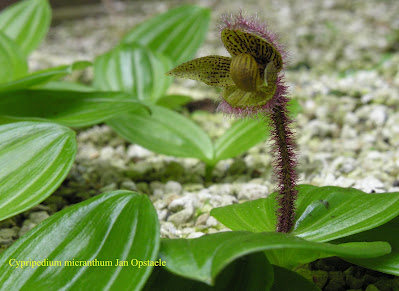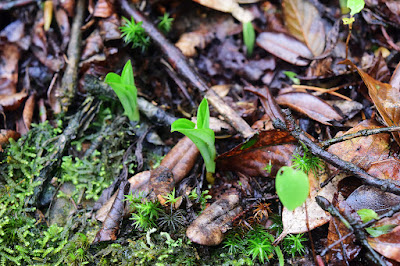Cypripedium micranthum, also called as The Small Flowered Cypripedium is found growing in moist well-drained soils, steep places in humus rich...
Cypripedium micranthum, also called as The Small Flowered Cypripedium, is a species of the genus Cypripedium. This species was described by Adrien René Franchet in 1894.
IDENTIFY CYPRIPEDIUM MICRANTHUM - THE SMALL FLOWERED CYPRIPEDIUM
Cypripedium micranthum is native to China. It is found growing in moist well-drained soils, steep places in humus rich or organic soils, from acid to alkaline soils of shady slopes in woods on limestone scree in north Sichuan (Jiuzhaigou, Pingwu) and north Chongping at elevations of 2000-2500 meters above sea level.
It is a miniature to small sized, cold growing terrestrial which reaching 8-10 cm tall with with an elongate slender creeping subterranean rhizome. The stem are erect, 2-6 cm, glabrous, with 2 or 3 sheaths at base and a subopposite leaf and bract. The leaves are subopposite, spreading, prostrate on substrate, obovate-elliptic or elliptic, shortly apiculate, 3.3-9 cm long, 2-6.5 cm wide, green, occasionally red spotted, deeply longitudinally veined, glabrous.
The Small Flowered Cypripedium blooms in the spring and early summer from the terminal, erect, 1-flowered inflorescence without a floral bract. The yellow flowers are small, with blackish purple spots and short stripes on sepals and petals and red spots and stripes on lip and tinged with white around its mouth.
CYPRIPEDIUM MICRANTHUM - THE SMALL FLOWERED CYPRIPEDIUM CARE AND CULTURE
Cultural information should only be used as a guide, and should be to be adapted to suit you. Your physical location; where you grow your plants, how much time you have to devote to their care, and many other factors, will need to be taken into account. Only then can you decide on the cultural methods that best suit you and your plants.
Light:
Cypripedium micranthum needs light shade to high open shade (70% shade cloth is satifactory). Though they grow in full sun in the wild, under cultivation they do not need that much light. It also reduces the moisture demand which is by far greater with more light. During winter protection from direct sun is beneficial, for potted plants essential, in order to prevent the plants from thawing during daytime. Otherwise the temperature fluctuation causes losses, especially in the first winter after potting.
Temperature:
The Small Flowered Cypripedium need a limit daily maximum temperatures to less than 26°C in summer and a minimum winter nighttime temperature of 4 to 7°C, with daytime temperatures of 10 to 16°C. In winter temperatures of -20°C or lower are no problem, even for potted plants. Additionally, covering the pots with brushwood from spruce trees is recommended.
Humidity:
The plant like humidity levels of around 50%. Too dry air has a negative effect on the development of the plant: its growth is inhibited, and the leaves begin to turn yellow and dry out. The higher temperature, the higher the humidity should be, and the higher the humidity, the more often and longer it is necessary to ventilate the room where the plants are contained, otherwise the probability of rotting and various kinds of fungal diseases.
Substrate, growing media and repotting:
cCypripedium micranthum an be grown in large pots and require repotting about every 4 to 5 years. They prefer a well-aerated and free draining humus rich soil that does not readily dry out. Adding perlite to improve drainage and aeration is recommended.
When repotting place the bud just at the surface of the potting mix but do not bury it. It can be covered with a light dressing of sand or fine gravel to protect it from pests.
Watering:
The Small Flowered Cypripedium like to be moist, but they won't tolerate getting soaked on a constant basis. You don't want to allow them to dry out either, and you should water them twice a week during the growing months from April through October. From October through the end of May, these orchids go into a dormant period where they require less water and fertilizer. You can cut back your watering to once a week with periodic checks to ensure they're staying moist.
Watering is directly dependent on the temperature of the content, the higher it is, the more often it needs to be watered. When watering, excess water should flow freely from the pot, since stagnation of water both inside the pot and in its pan can very quickly lead to rotting of the roots and the lower part of the plant.
Fertilizer:
Fertilizing is especially important during the formation of the shoots in spring. The leaves should always be vibrant green. Most common fertilizers for perennials are suitable; best are those with a long-term effect. As soon as you notice new growth beginning at the start of the growing period, you should feed your orchid every 10 days with a diluted half strength balanced fertilizer. You can alternate this balanced fertilizer with a seaweed-based fertilizer every other feeding. When your orchid goes dormant, you can stop fertilizing them throughout their dormant period. They won't need it until you start to see new growth in the spring, and then you can resume feeding your orchid every 10 days.
Rest period:
Cypripedium micranthum need a rest period at 0-4 ° C and kept in the dark for at least 3 months with less water in the winter, especially if they grow under the conditions of a dark, short day that occurs at moderate latitudes. They should dry somewhat between waterings, but they should not be dry for a longer period. Frequent morning fogging and rare, economical watering should allow the plant to go through a dry period of rest, while providing it with sufficient humidity. Fertilization should be reduced or eliminated until new growths appear and a more abundant spring watering begins.
BUY CYPRIPEDIUM MICRANTHUM - THE SMALL FLOWERED CYPRIPEDIUM AND RELATED PRODUCTS
BUY ANOTHERS SPECIES AND VARIETIES OF CYPRIPEDIUM ORCHID GENUS HERE!















COMMENTS